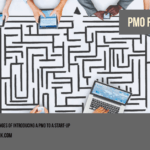In the last post, “Why standardization is critical for your PMO“, it covered some of the key themes why standardization will benefit and help the success of your PMO. The question is, where do you start if your organisation has little or no standards? Every project is doing it’s own thing!
In this post I would like to share some thoughts how you can set about defining and introducing PMO standards and my suggestion for the process to standardize first. Before we start, I would like to share an important bit of advice that was shared with me a number of years ago, “don’t try to boil the ocean”.
The principle being, when there is a lot to do, in this case implement standards across the entire PMO functions, do not try to do every thing at once and do not aim for perfection. If you do it is highly likely you will fail.
Pick “one thing”
I am a big fan of the book “The One Thing“. The idea is simple, pick the one thing that will make the biggest difference and then focus on getting that completed.
If you follow this principle, instead of having a number of items that are half finished and not ready, you have one item that is finished that can be used. Meaning you gain the benefit.
The other reason why this is important is that with the exception of a very few people, most of us cannot multi task. We simply switch between activities (sometimes very quickly). The time lost switching between activities on a continual basis takes time and energy.
So in your journey of PMO standardization, pick one area to focus on that will provide significant benefit.
Current process
Before you can start standardizing a process, you should take time to understand the current process. So, taking the area you have picked as your area of focus, set about mapping the current process.
This will involve engaging the numerous project teams to understand what process they are following. You should also try to gain an insight to what is causing them pain.
Completing this step will result in:
- Understanding of how the process is being executed by the different teams
- Areas that need improvement
Analysis
After capturing the current process, you need to conduct analysis to understand areas of similarities and existing processes that can be leveraged. This is important as it is far easier to adapt and build on existing processes than create a new process.
Additionally if there is a number of projects using a similar process, it is far easier to get them to make small changes to standardize as opposed to introducing a new process.
Document proposed process
In order to implement a changes, you need to be able to communicate the changes in a simple and clear way. This ensures that there is a common understanding.
Aim to document the process in a simple and easy to understand way that can be shared with the stakeholders.
Communicate process
Set up sessions to communicate the proposed process with the stakeholders who will be using the process. Explain the proposed changes and benefits.
It is important to take feedback from the stakeholders and, update the approach where appropriate. This will result in a better process. Additionally if the stakeholders feel they have helped shape the process and their input has been considered, it becomes a shared solution with a higher chance of adoption.
Support and feedback
After you have set a date and implemented, it is important to provide support to help the teams adopt the process. Make sure they know where they can get help.
You should also monitor the process and take feedback so that you can make adjustments to improve. I suggest that you allow a bedding in period of 2 – 4 weeks before making changes.
Thoughts on what PMO process to pick first
The above provides a good framework for standardizing any process. However, the question is where to start?
Every organisation is different and the current drivers / pain points mean you already know the answer. If not one of the easiest and most beneficial areas to start is project reporting. Implementing a standard reporting process means far more accurate reporting and it is visible and provides benefit to senior management.
The article, “5 tips on PMO template design” will provide useful guidance.
Summary
PMO standardization has many benefits. Following the steps in this guide will allow you to quickly select and standardize a PMO process. Then you simply select the next process and repeat.






